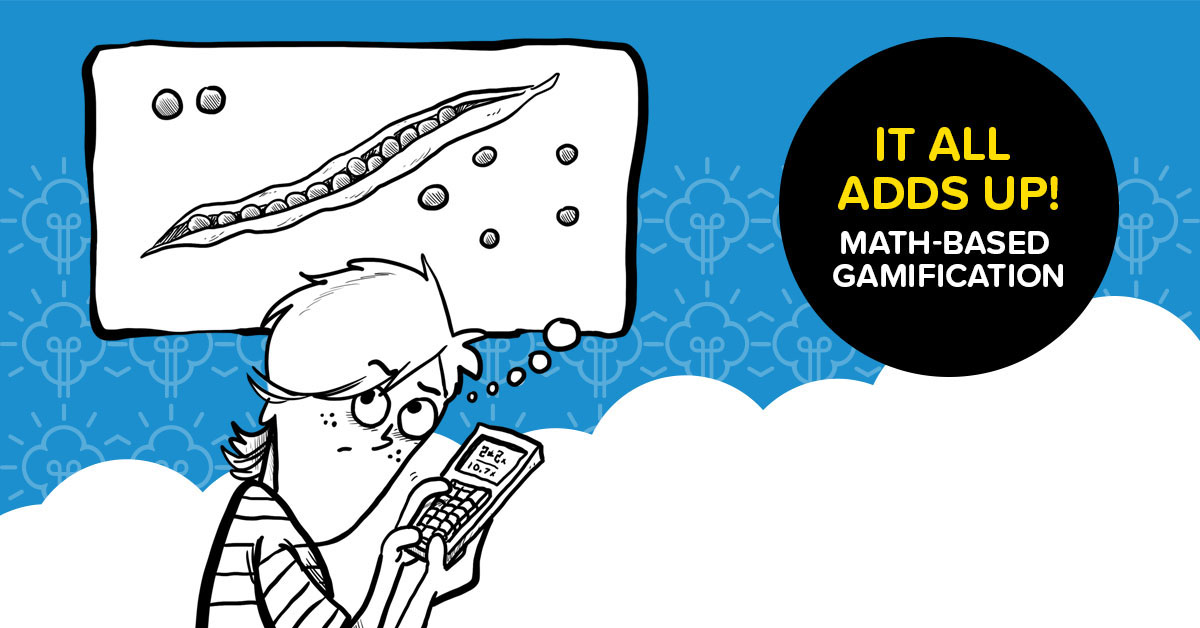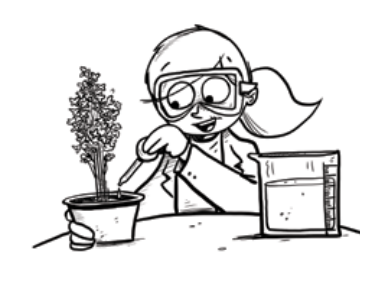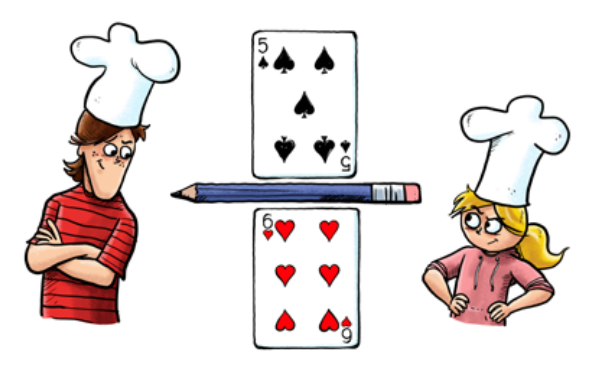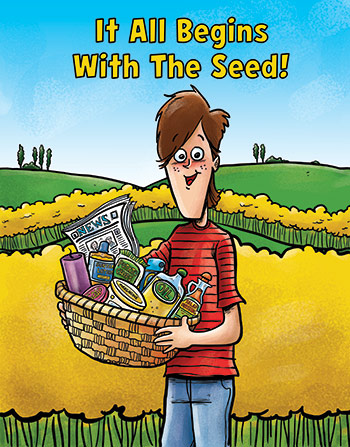
It All Begins With The Seed Activities
(Grades 1-3)
The math-related activities below can be found in the “It All Begins With The Seed” activity book. The STEM-based activity book will assist learners improve their numeracy and literacy skills, while learning all about agriculture, canola production, canola science, and health. These activities are aligned with math curriculum outcomes for grades 1-3.

Kindergarten
Let’s Play: What Do You See: How Many Canola Flowers, Ladybugs, and Bees?
Did you know? Canola fields are essential for a variety of beneficial insects such as bees, butterflies, spiders, wasps and beetles. Not only do the fields provide a habitat for the insects but the insects in turn help increase crop yields and provide a natural check on insect pest populations.
In this activity, identify how many canola flowers, ladybugs and bees you see on the canola plant. Colour all the flowers yellow, ladybugs red, and the bees yellow. Record your number in the answer box below the canola plant for each plant shown.
Math learner outcomes addressed
- Representing a quantity in different ways
- Relating a numeral to a specific number

Grade 1
Let’s Play: Doubles Aren’t Trouble!

From one canola seed we can grow many more! Did you know that on average, 1 canola seed, which produces 1 canola plant, will produce an average of 60-100 pods? Each pod will produce approximately 20-30 canola seeds?
Practice your adding in the Doubles Aren’t Trouble activity, roll one die and double your answer to see how many possible canola plants will grow from one seed!
Math learner outcomes addressed
- Representing quantities using words, numerals, objects, or pictures.
- Recognizing quantities to 10.
- Counting within 100, forward by 1s, starting at any number, according to the counting principles.
- Visualizing quantities between 10 and 20 as compositions of 10 and another quantity.
- Modeling addition within 20 in various ways.
- Relating addition to various contexts involving composition or decomposition of quantity.
- Investigating addition strategies.
- Adding within 20.
- Checking sums using inverse operations.
- Expressing addition symbolically.
- Recalling addition number facts, with addends to 10.
Let’s Play: Find the Field – Colour by Number
Did you know that canola is a Canadian invention? Canola was developed in the 1970s, using traditional plant breeding techniques, by Canadian plant breeders.
The name ‘Canola’ comes from ‘CAN’ as in Canada and ‘OLA’ as in oil!
In this activity, find the hidden canola field by counting and coloring the objects in the picture.
Math learner outcomes addressed
- Represent quantities using words, numerals, objects, or pictures.
- Identify a quantity of 0 in familiar situations.

Grade 2
Let’s Play: Connect Four-Addition!
Did you know that on average, 1 seed, which produces 1 canola plant, will produce an average of 60-100 pods? Each pod will produce approximately 20-30 canola seeds? In Connect Four: Addition, practice your adding and see how many possible canola plants will grow from one seed!
Math learner outcomes addressed
- Visualize quantities between 10 and 20 as compositions of 10 and another quantity.
- Model addition within 20 in various ways, including with a balance.
- Investigate addition strategies.
- Add and subtract within 20 and 100.
- Recall addition number facts, with addends to 10.
- Count within 1000, forward and backward by 1s, starting at any number.
- Compare and order natural numbers.

Let’s Play: How Much Water to Grow a Bee-you-tiful Golden Flower?
Just like other plants, canola plants need fertilizer (food), water, sunlight, and the right temperature to grow.
In this activity, find out how different amounts of water affects the growth canola plants producing more flowers. You will create and read your results from a bar graph.
Math learner outcomes addressed
- Decomposing quantities into groups of 100s, 10s, and 1s.
- Counting within 1000, forward and backward by 1s, starting at any number.
- Describing a quantity as less than, greater than, or equal to another quantity.
- Recalling and applying addition number facts, with addends to 10, and add numbers within 100.
- Recording data in a table.
- Constructing graphs to represent data.
- Interpreting graphs to answer questions.
- Comparing the features of pictographs, dot plots, and bar graphs.

Let’s Play: Elimination!
Good insects that help the growth of plants, are called beneficial insects, and the insects that are harmful to plants are called non-beneficial insects.
In Elimination, you will pretend you are a canola farmer trying to get rid of the bad insects that are harming your canola plant and practice addition and subtraction.
Math learner outcomes addressed
- Representing quantities using words and natural numbers.
- Decomposing quantities into groups of 100s, 10s, and 1s.
- Counting within 1000, forward and backward by 1s, starting at any number.
- Skip counting by 2s and 10s, starting at any number.
- Recalling and applying addition number facts, with addends to 10, and related subtraction number facts.
- Investigating strategies for addition and subtraction of two-digit numbers.
- Adding and subtracting numbers within 100.
- Verifying a sum or difference using inverse operations.

Grade 3
Let’s Play: One Metre Canola Dash Madness!
Did you know canola plants grows roughly between 1m-2m tall? The average pod length for canola is 5 cm and the diameter of a seed is 1 mm. (Diameter is the longest distance across a circle from edge to edge of the circle.)
In this activity challenge other friends in your class to see who can estimate and measure objects around your classroom the most accurately with the help of your teammates.
Math learner outcomes addressed
- Relating millimetres, centimetres, and metres.
- Justifying the choice of millimetres, centimetres, or metres to measure various lengths.
- Measuring lengths of straight lines and curves, with millimetres, centimetres, or metres.
- Recognizing length expressed in metric or imperial units.
- Approximating a measurement in inches, feet, or yards using centimetres or metres.
- Identifying referents for a centimetre and a metre.
- Estimating length by comparing to a benchmark.
- Estimating length by visualizing the iteration of a referent for a centimetre or metre.
Let’s Play: Area and Perimeter of a Canola Field!
Did you know, every year before seeding a farmer has to think about the area of canola and other crops they want to grow. They start planning very early for this to make sure they have enough seed and fertilizer during seeding time. In this game, you will pretend you are a canola farmer and you will determine the area and perimeter of your field to get the best canola growth possible.
Math learner outcomes addressed
- Multiplying within 100.
- Determining an unknown value on the left or right side of an equation, limited to equations with one operation.
- Solving problems using equations, limited to equations with one operation.
- Relating millimetres, centimetres, and metres.
- Measuring lengths of straight lines with centimetres.
- Recognizing length expressed in metric or imperial units.
Let’s Play: Back to Back!
As you can imagine, during seeding, a farmer must know how to add and multiply so they get the best yield possible. Are you as sharp as a canola farmer? In this game, you will demonstrate how well you can add and multiply to determine the best canola yield possible!
Math learner outcomes addressed
- Relating strategies for the addition of two-digit numbers to strategies for the addition and subtraction of three-digit numbers.
- Adding natural numbers using standard algorithms.
- Multiplying and dividing within 100.
- Expressing multiplication symbolically.
- Examining patterns in multiplication, including patterns in multiplication tables and skip counting.
- Recognizing families of related multiplication number facts.
- Recalling multiplication number facts, with factors to 10.
Let’s Play: The Quickest Chef!

Chefs have to sometimes improvise and substitute ingredients. Did you know you can use canola oil in place of butter or shortening in cookie recipes to make a more heart healthy cookie?
You and another chef will play a round of The Quickest Chef to use your knowledge of fractions to determine who can substitute canola for shortening the quickest!
This game is similar to the card game, war. The winner wants to have the largest pile of cards by the end of the game.
Math learner outcomes addressed
- Identifying the numerator and denominator of a fraction in various representations.
- Naming a given fraction.
- Expressing fractions, including one whole, symbolically, limited to denominators of 12 or less.
- Relating various representations of the same fraction, limited to denominators of 12 or less.
- Comparing the same fraction of different-sized wholes.
- Comparing different fractions of the same whole that have the same denominator.
- Comparing different fractions of the same whole that have the same numerator and different denominators.
- Expressing the relationship between two fractions of the same whole, using <<, >>, or =.
- Relating a fraction less than one to its position on the number line, limited to denominators of 12 or less.
- Comparing fractions to benchmarks of 0, 1/2, and 1.
Let’s Play: Stand Up, Sit Down!
Dairy cows produce an average of 30 litres of milk per day! When fed a diet that includes canola meal, they can produce an extra litre of milk per day. That all adds up! In this activity, let your multiplication and addition skills shine!
Math learner outcomes addressed
- Multiplying and dividing within 100.
- Expressing multiplication symbolically.
- Examining patterns in multiplication, including patterns in multiplication tables and skip counting.
- Recognizing families of related multiplication number facts.
- Recalling multiplication number facts, with factors to 10.
Let’s Play: Let there be cake!
Canola oil is used to cook all sorts of types of tasty treats like cakes and cookies! To make these tasty treats we have to measure ingredients like canola oil during baking, which requires precision and precision involves fractions. Show off your super-mad-fraction-baking-skills in this game!
Math learner outcomes addressed
- Identifying the numerator and denominator of a fraction in various representations.
- Naming a given fraction.
- Expressing fractions, including one whole, symbolically, limited to denominators of 12 or less.
- Relating various representations of the same fraction, limited to denominators of 12 or less.
- Comparing the same fraction of different-sized wholes.
- Comparing different fractions of the same whole that have the same denominator.
- Comparing different fractions of the same whole that have the same numerator and different denominators.
- Expressing the relationship between two fractions of the same whole, using <<, >>, or =.
- Relating a fraction less than one to its position on the number line, limited to denominators of 12 or less.
- Comparing fractions to benchmarks of 0, 1/2, and 1.

